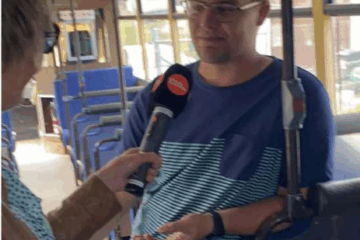Canberra Transport Museum is taking ACTION to keep capital’s public transport heritage alive

Museum treasurer Brock Ginman, presidet Zac Mathes, director Joshua Cox, and members representative John Tokaji with some of the ex-ACTION buses, currently parked in a yard in Yass, they’ll be restoring to their former glory for a new museum site. Picture: Dion Georgopoulos
Take a retired ACTION bus for a drive around the streets of Yass and you’ll be guaranteed to get some funny looks.
The team behind the fledgling Canberra Transport Museum are well accustomed to the stares, scratched heads and confused gawks when people cotton on to the sight of an old Canberra icon over the border.
From a back lot in the NSW town, the museum’s members are assembling a unique collection to keep the capital’s public transport heritage alive.
“The way I explain it to people – because they do look at you funny when you tell them about it – it’s just a bigger version of owning a classic car,” museum director Joshua Cox said.
“If you want to buy a ’60s Mustang, it’s going to cost you three times what we pay for these.”
The new star of the collection is Bus 717, an articulated Renault PR180.2 which entered service in 1988. Withdrawn in 2013, the museum recently rescued it from a paddock where it had sat in original condition for the better part of a decade.
“Bar the mixed seat fabrics from when they’ve swapped seats out, it’s pretty much as it was its entire service life. I think the only thing they came close to for renewal is in the last few years of service when they put MyWay in,” Mr Cox said.
Another prized item in the collection is Brock Ginman’s dinosaur bus, a Renault PR100.2 which since it first entered service in 1992 was emblazoned with a painted dinosaur skeleton and the legend: “Take ACTION … conserve our fossil fuels.”

John Tokaji, Zac Mathes, Brock Ginman and Joshua Cox in the back seat of Mr Ginman’s Bus 967. Picture: Dion Georgopoulos
Mr Ginman feels the weight of responsibility to restore the bus and maintain a unique piece of Australian Capital Territory Internal Omnibus Network history.
“But it’s good. I’ve loved it for a long time. I actually arranged to hire it for my school formal,” Mr Ginman, who bought the bus from ACTION last year, said.
Just don’t ask about the fuel bill: “That’s 200 litres [a tank] and I haven’t done a full fill up,” Mr Ginman said. “I’ve put 150 litres in and that’s about $170.”
“It’s an expensive hobby,” Canberra Transport Museum members’ representative John Tokaji said.
There’s the constant need for parts and tyres, while finding a storage site poses its own challenges.

ACTION buses parked in Civic during a drivers’ strike. Picture: Richard Briggs
Eventually, the museum hopes to secure a site in Canberra where the public can see the collection.
“It’s the biggest undertaking. It’s more of a pain than the vehicles themselves,” Mr Cox said.
“Because you’ve got to find somewhere big enough. Always preference undercover, because it’s quite a lot of money to repaint them every five years when they fade, and finding somewhere that’s central that people can get to.
You wouldn’t bring people out here [to Yass] because it’s too far. You’ve still got to stay in that tourist zone, but we will get there.”
In the meantime, the museum plans to run buses in this year’s Rise Above Cancer Convoy, offering tickets to ride along in the buses while raising money for charity.
Any talk of a motor-home conversion is sacrilegious at this museum, which wants the orange and blue buses – each with more than 2 million kilometres on the clock – driven long into the future.
“It’s very nostalgic. It wasn’t that long ago, but still the time after they’re withdrawn, they’re never to be seen again,” Mr Tokaji said.
“We’re trying to change that.”

